
Antonio José de Sucre y Alcalá, known as the "Gran Mariscal de Ayacucho", was a Venezuelan general and politician who served as the president of Bolivia from 1825 to 1828. A close friend and associate of Simón Bolívar, he was one of the primary leaders of South America's struggle for independence from the Spanish Empire.
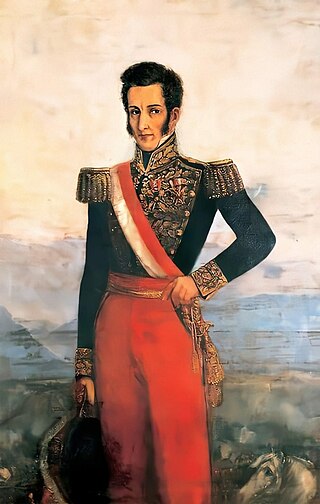
José Domingo de la Merced de La Mar y Cortázar was a Peruvian military leader and politician who served as the third President of Peru.

The Battle of Ayacucho was a decisive military encounter during the Peruvian War of Independence. This battle secured the independence of Peru and ensured independence for the rest of South America. In Peru it is considered the end of the Spanish American wars of independence in this country, although the campaign of Antonio José de Sucre continued through 1825 in Upper Peru and the siege of the fortresses Chiloé and Callao eventually ended in 1826.
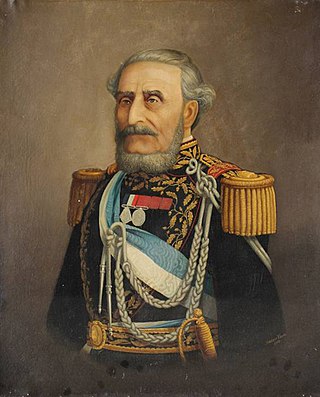
Juan Esteban Pedernera was interim President of Argentina during a brief period in 1861.
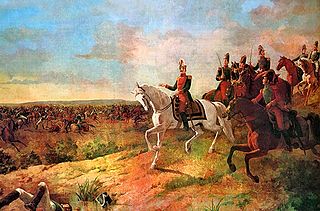
The Battle of Junín was a military engagement of the Peruvian War of Independence, fought in the highlands of the Junín Region on 6 August 1824. The preceding February the royalists had regained control of Lima, and having regrouped in Trujillo, Simón Bolívar in June led his rebel forces south to confront the Spanish under Field Marshal José de Canterac. The two armies met on the Plain of Junín in the Bombon Plateau, northwest of the Jauja Valley.
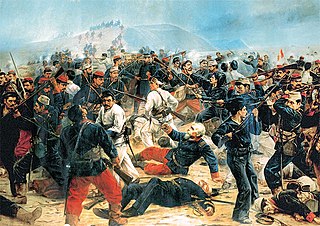
The Battle of Arica, also known as Assault and Capture of Cape Arica, was a battle in the War of the Pacific. It was fought on 7 June 1880, between the forces of Chile and Peru.

Grand Marshal Juan Gregorio de las Heras was an Argentine soldier who took part in the Spanish American wars of independence and was also a governor of the province of Buenos Aires.

Marcos Maturana del Campo was a Chilean military and political figure who served in the Chilean War of Independence and the War of the Confederation.
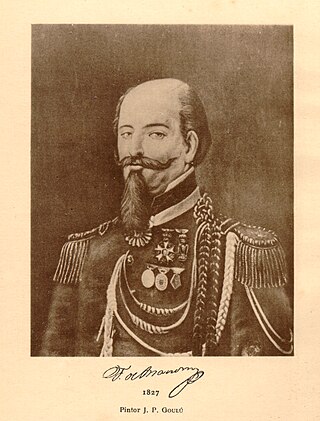
Carlos Luis Federico de Brandsen was a Colonel of French origin who fought in many of the South American wars of independence and for Argentina in the War with Brazil.

The Regiment of Mounted Grenadiers "General San Martín" is the name of two Argentine Army regiments of two different time periods: a historic regiment that operated from 1812 to 1826, and a modern cavalry unit that was organized in 1903.

The Army of the North, contemporaneously called Army of Peru, was one of the armies deployed by the United Provinces of the Río de la Plata in the Spanish American wars of independence. Its objective was freeing the Argentine Northwest and the Upper Peru from the royalist troops of the Spanish Empire. It was headed by Hipólito Vieytes (1810), Juan José Castelli (1810–1811), Juan Martín de Pueyrredón (1811–1812), Manuel Belgrano (1812–1814), José de San Martín (1814), José Rondeau (1814–1816), Manuel Belgrano (1816–1819) and Francisco Fernández de la Cruz (1819–1820).
Sixto Casanovas, was an Argentine politician, provisional governor of Córdoba Province (1835).
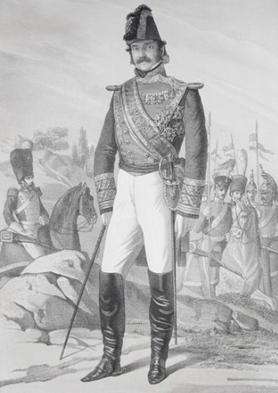
Valentín Ferraz y Barrau was a Spanish military commander and politician. After fighting in the Peninsular War and in the Peruvian War of Independence Valentín engaged in the chaotic politics of the post-war reign of Isabella II of Spain, serving as Prime Minister of Spain in 1840 and holding other important offices such as Mayor of Madrid.

The 3rd Dragoon Regiment was a cavalry regiment in the French Army, it was active in various forms from 1649 to 1997.

Leoncio Prado Gutiérrez, was a Peruvian soldier and adventurer who participated in various military actions against Spain; in Cuba and the Philippines in the 1870s. He also participated in other wars such as the Chincha Islands War (1865-1866) and the War of the Pacific (1879-1883), dying in the latter.

The Protectorate of Peru, also known as the Protectorate of San Martín, was a protectorate created in 1821 in present-day Peru after its declaration of independence from the Spanish Empire. The protectorate existed for one year and 17 days under the rule of José de San Martín and Argentina.

The 2nd Dragoon Regiment is the only NBC Defense Unit of the French Army, stationed at Fontevraud-l'Abbaye, by Saumur in Maine-et-Loire. The current regiment is an amalgamation of the old 2nd Dragoon Regiment and the groupe de défense NBC, which took effect in July 2005. It incorporates the capabilities of the previous 2nd Dragoons, which was specialised as a reconnaissance unit, in a new mission as the sole French Army unit dedicated to combatting chemical, biological, radiological, and nuclear (CBRN) weapons.
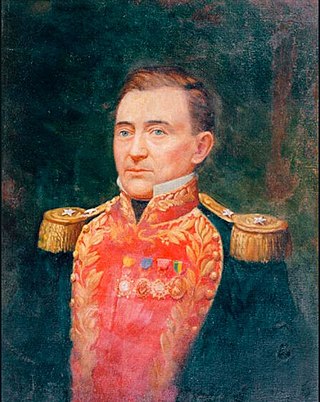
Thomas Charles Wright (1799–1868) was an Irish-born naval admiral. He was the founding-father of the Ecuadorian Navy, and a general in Simón Bolívar's army. He is regarded as a leading militarist in Ecuador's and other South American countries' struggle for independence.

Sofanor Parra Hermosilla, was a Chilean military officer who served in the Chilean Army, in the cavalry branch, and who reached the rank of divisional general.

The second siege of Callao was the longest lasting siege that occurred on the Pacific coast during the Spanish American wars of independence. The siege was carried out by the combined Gran Colombian and Peruvian independence forces against the royalist soldiers defending the Real Felipe Fortress in the port of Callao, who refused to surrender, and refused to accept the capitulation of the Battle of Ayacucho.

















